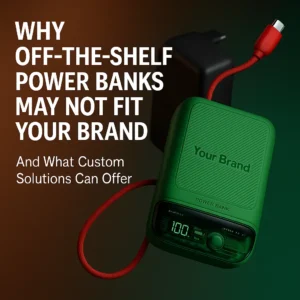If you’re looking for a power bank design company that can deliver next-gen performance and compatibility, understanding PD3.1 is essential. As demand grows for power bank 3D modeling services, power bank PCB design, and highly efficient fast charging power bank design, PD3.1 is shaping the future of portable power. Combined with expert power bank custom engineering, it enables your brand to deliver real innovation.
1. What Is PD3.1 and Why It Matters Now
PD3.1 (USB Power Delivery 3.1) is the latest USB-C fast charging standard introduced by USB-IF. While PD3.0 supports up to 100W, PD3.1 introduces EPR (Extended Power Range), pushing the maximum output to 240W (48V/5A).
This increase in power opens the door to new categories of devices:
- High-end gaming laptops
- Portable 4K monitors and docking stations
- Advanced camera rigs and studio lighting
- Smart headsets, AR/VR glasses, and mobile workstations
As devices become more power-hungry and compact, battery packs and adapters must keep pace. PD3.1 ensures your design is ready for the next generation of tech.

2. PD3.0 vs. PD3.1: What’s Different?
| Feature | PD3.0 | PD3.1 (EPR) |
|---|---|---|
| Max Power | 100W (20V/5A) | 240W (48V/5A) |
| Voltage Steps | 5V, 9V, 15V, 20V | Adds 28V, 36V, 48V |
| Use Cases | Phones, tablets, laptops | High-end laptops, displays, hubs |
| Cable Requirement | Standard USB-C | EPR-certified cable with E-Marker |
| Safety Requirements | Standard OVP/OTP/OCP | Enhanced safety protocols & handshake authentication |
3. Engineering Challenges in PD3.1 Battery Design
Designing a PD3.1-capable power solution goes far beyond adding a USB-C port:

- Thermal Management: Higher voltage = more heat. Thermal pads, copper pour layers, and real-time temperature feedback become critical.
- Power Regulation: You’ll need buck/boost converters rated for 48V+ with precise control to maintain safety and efficiency.
- BMS Integration: Battery management systems must intelligently coordinate with PD controllers to avoid voltage overshoot or brownout.
- Cable & Connector Selection: Only E-Marked USB-C cables rated for 5A and 48V will work safely — an often-overlooked detail.


Without expert guidance, attempting PD3.1 integration can lead to overheating, device failure, or certification rejection.
4. Who Needs PD3.1-Ready Power Banks?
These devices and user types can benefit the most:
- Gaming Laptops: Portable chargers that deliver full 240W for power-hungry rigs.
- Industrial Field Gear: Tools and tablets that operate in remote locations.
- Pro Video Equipment: Live broadcast cameras, lights, and recorders needing stable, high output.
- AR/VR Headsets: Head-mounted displays and controllers require small yet high-output battery packs.
By designing with PD3.1 in mind, you’re preparing your product line for long-term relevance.
5. How WokooDesign Delivers PD3.1-Capable Solutions
As a power bank design company with full-stack development capabilities, WokooDesign can support you at every stage:
- Electrical Architecture: We handle high-voltage circuit topology, PD controller selection, and firmware tuning.
- Mechanical Engineering: Our 3D modeling services ensure space-efficient layouts and airflow design.
- Custom PCB Design: Compact, multi-layer boards with dedicated copper zones for heat management.
- Protocol Validation: Fast charging PD3.1 handshake testing, EPR cable detection, and compliance with USB-IF standards.
- Global Certification: We help prepare your product for CE, FCC, UN38.3, and airline regulations.

Ready to Design a PD3.1 Power Bank That Performs?
Don’t wait for your competitors to lead the future.
Let’s build a power bank that delivers on performance, safety, and design — from concept to mass production.
Reach out to WokooDesign today and future-proof your power solution.



